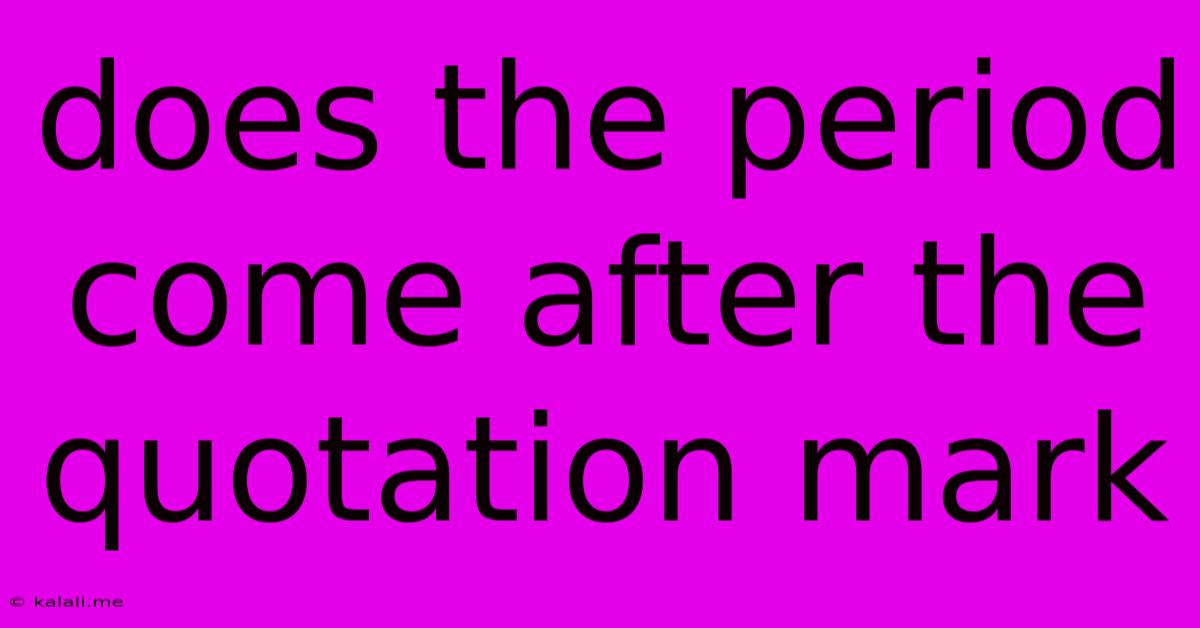Does The Period Come After The Quotation Mark
Kalali
May 31, 2025 · 3 min read

Table of Contents
Does the Period Come After the Quotation Mark? A Definitive Guide to Punctuation
Meta Description: Learn the correct punctuation for quotations: Should the period go inside or outside the quotation marks? This guide clarifies the rules, providing examples and exceptions for both American and British English.
The placement of punctuation marks in relation to quotation marks is a common source of confusion. Many writers struggle to remember whether a period should go inside or outside the closing quotation mark. The answer, however, isn't as simple as a single rule. It depends on your style guide: American English follows different rules than British English.
American English Style: Periods and Commas Inside
In American English style (and many other styles), periods and commas always go inside the closing quotation marks, regardless of whether the quotation is a complete sentence or a fragment.
- Example 1 (Complete Sentence): He said, "The cat sat on the mat."
- Example 2 (Sentence Fragment): She yelled, "Look out!"
- Example 3 (Commas): The report stated, "The numbers are, unfortunately, incorrect."
This rule applies consistently for periods, commas, and other internal punctuation like question marks and exclamation points within direct quotations.
British English Style: Periods and Commas Outside (Mostly)
British English style generally places periods and commas outside the closing quotation marks, unless they are part of the original quotation. This rule can lead to some exceptions and nuances.
- Example 1 (Complete Sentence): He said, "The cat sat on the mat".
- Example 2 (Sentence Fragment): She yelled, "Look out!".
- Example 3 (Exception): He asked, "Where are you going?". (The question mark is part of the original quote).
This distinction can sometimes create ambiguities, especially in complex sentences. Consistency is key, so stick to one style consistently throughout your writing.
Other Punctuation Marks: A Quick Guide
The placement of other punctuation marks can depend on context and style guide. However, generally:
- Question Marks and Exclamation Points: These go inside the quotation marks if they are part of the quoted material; otherwise, they go outside.
- Colons and Semicolons: These always go outside the quotation marks.
Example:
- "The meeting is adjourned," she announced; however, several members lingered.
Consistency is Key
Regardless of whether you follow American or British style, consistency is paramount. Choose one style and stick with it throughout your document. This ensures clarity and professionalism in your writing. Your chosen style should also be clearly identified in your writing guidelines if applicable, especially for academic papers or collaborative projects. Inconsistent punctuation can distract the reader and undermine the credibility of your work. Many word processors and writing programs have style settings to help you enforce consistency.
Conclusion: Master Your Quotation Marks
Understanding the rules surrounding quotation marks and punctuation may seem trivial, but mastering these nuances elevates your writing to a higher level of professionalism. By applying these guidelines consistently, you'll produce clear, readable, and grammatically correct text. Remember to check your chosen style guide regularly for any updates or refinements to these rules.
Latest Posts
Latest Posts
-
Map Of Land Promised To Abraham
Jun 02, 2025
-
How To Find Sum Of Maclaurin Series
Jun 02, 2025
-
Electric Field On Surface Of Conductor
Jun 02, 2025
-
Relative Extrema A Nth Degree Polynomial
Jun 02, 2025
-
How Long Does It Take For Loctite To Dry
Jun 02, 2025
Related Post
Thank you for visiting our website which covers about Does The Period Come After The Quotation Mark . We hope the information provided has been useful to you. Feel free to contact us if you have any questions or need further assistance. See you next time and don't miss to bookmark.